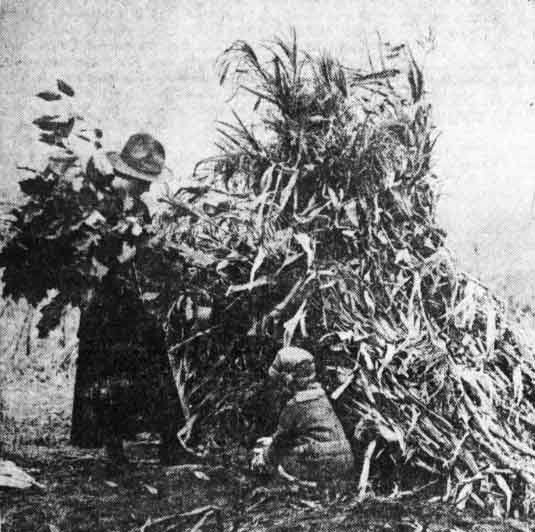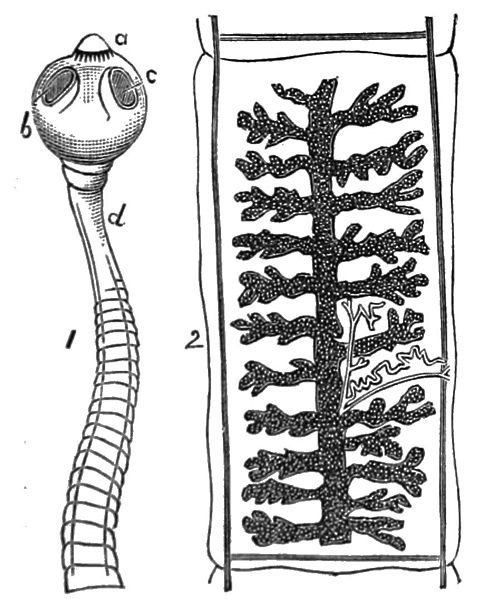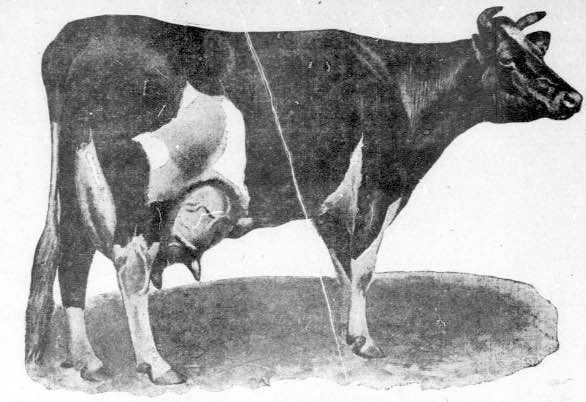
In 1902, a 34-year-old man was admitted to the London Hospital for having a tapeworm. He didn’t survive the medication they gave him and upon giving him an autopsy, doctors found the tapeworm was over 20 feet long. A few years later, in 1909, a 10-year-old boy survived the removal of a 26 foot long tapeworm. Both of these incidents were exceedingly common over 100 years ago when people did not prepare their food correctly and drank contaminated water.
Even today, there are frightening incidents of tapeworms being found living inside the brains and eyes of people who ate raw meat or traveled to impoverished areas where clean water is scarce. The main difference between then and now is that we have the dewormers and surgical skills to make tapeworm removal a safer process than it once was. [Sources 1 and 2]

Beef Measles
In 1913, it was estimated that about 1 percent of all United States beef was infested with something called beef measles. While at first it sounds like a disease that could be cured by a vaccine, it is actually an infestation of tapeworms. The infested cows consumed tapeworm eggs and when the eggs hatched they burrowed into the cow’s meat. After the cow is butchered, the meat looks like it has white cysts on it, commonly referred to as measles. If the measle meat made it past the meat inspectors and onto the dinner plate, it could infect other people if undercooked. An unfortunate person, if not paying attention, could eat several of these cysts containing tapeworms and become severely infested. [Source]
One poor fellow in Melbourne, back in 1904, had a 20-foot beef tapeworm removed from his internal organs. Its size so surprised a government bacteriologist that the doctor preserved it and kept it in his laboratory. [Source]

Beef Tapeworms Found In Babies And Toddlers
While discovering tapeworms inside adults was a fairly common occurrence in the United States and in other countries where the people were prone to eating beef or pig, finding a tapeworm in a toddler, aged 14 to 18 months is another ordeal.
One Connecticut doctor discovered that a beef tapeworm had infested a young child. It was possible that the Polish parents used an old remedy for diarrhea where raw or rare beef is scraped from the bone and fed to the young child. As a result, the child would get a tapeworm and start passing tapeworm segments.
Another case of tapeworm found in young children included an 8 month old baby that was “fed a half pound of minced beefsteak daily.” The beefsteak was probably undercooked and the parents were obviously ignorant as to what babies should be eating at that age. Another baby, only 9 months old, was being fed raw beef juice. It is not surprising that the infant was discovered to have had tapeworms.
A 1915 newspaper article detailing these tapeworm infestations ends: “Reports of cases of tapeworm in 5 day old infants must be regarded as apparently due to error or confusion of some sort.” [Source]
Tapeworms Inside Chicken Eggs
The article from 1898 reads that a doctor “claims to have found a tapeworm in an egg which was served for his breakfast. He says that the egg had been cracked in boiling water, and when he took it from the dish, he saw what seemed to be a worm protruding from the crack. This worm was found to be coiled up and, when stretched out, proved to be 4 ft long.” [Source]
What fresh hell is this? Not only can beef, pig, sheep, cats, dogs, and fish contain tapeworms, but chicken eggs can also become infested with tapeworms and roundworms. Yum, right? What is worse is that people who sell their chicken eggs often don’t know there is a problem until a customer makes the effort to contact them.
Chickens will sometimes pick up tapeworms from eating garden slugs, snails, and earthworms. Other insects eaten by chickens can also carry tapeworm or tapeworm eggs. Contaminated water and dirty food can give chickens tapeworm, and one infected chicken can quickly pass it on to the rest of the healthy chickens. [Source]
From Pig To Human
A Sydney, Australia newspaper article remarked on the “curious history” of tapeworms and how the parasite needs two hosts to become the “perfect tapeworm.” The pig, a meat considered to be unclean by many people for both religious and health reasons, can easily get tapeworms from its diet. It swallows the tapeworm eggs found on its food, from raw vegetables to contaminated water. When the tapeworm eggs hatch, boring worms drill their way into the pig’s muscles, latch on, and form a white pocket around themselves.
The tapeworm infected pig meat will look “measly” with white spots. If undercooked and eaten, the surviving tapeworms will infect the person who becomes the second host. The tapeworm will attach itself to the lining of the intestines and grow to its full glory.
Any other animals that eat the infected pork will also get tapeworms, from the family’s cat and dog, to scavengers who eat unwanted leftovers thrown into the compost pile. [Source]
The Sheep Tapeworm Plague
We rarely hear about tapeworm infestations in livestock today. This is probably because the consumer finds it distasteful to contemplate parasites being in their food and because tapeworms can be eliminated with modern dewormers that were not available 100 years ago.
In 1913, reports started hitting the newspapers about a tapeworm plague among sheep flocks. A North Carolina newspaper printed that “[t]he plague of tapeworm is so widespread that reports from all over the world serve only to confirm our own bitter experience.”
It was estimated that shepherds were losing 30 to 40 percent of their flocks to tapeworms. At one time the remedy for tapeworms was a grain of arsenic, but as some farmers discovered, lambs rarely survived the arsenic treatment. Since they could not use this treatment, they turned to preventative methods and started to literally salt the earth. Crushed rock salt was spread over the pasture land at a rate of half a ton to an acre. [Source]
Dogs As Carriers
The farm dog was a useful friend and co-worker, keeping animals in check and predators at bay. By the early 1900s, the dog was also being accused of being a major carrier of diseases and parasites, from rabies to tapeworms.
Proper care of working dogs was being urged through numerous newspaper accounts and farming bulletins. Farmers were being warned against allowing dogs to eat the raw meat and leftovers of slaughtered animals. The dogs could easily consume the living heads of the tapeworm this way and pass tapeworm eggs to the livestock through its stool.
Farmers were told to boil the dog’s food before feeding him, to kill any living tapeworm heads or eggs. Surprising for the times (1915), the reporter notes that: “Proper feedings of the dog is essential and the owner who does not feed a dog properly has not right to keep one.”
Further instructions are given to farmers on keeping dogs free of fleas and ticks to help prevent the spread of tapeworms to both livestock and family members. [Source]
Coconut Milk Tapeworm Removal
Newspapers published a wide range of tapeworm remedies in the early 1900s. With people being too scared to eat beef and reports being put out about how easy it is to get tapeworms from cats and dogs, remedies were widely circulated.
One interesting remedy was published in The Newport Plain Talk, a newspaper out of Tennessee, in 1913. In it, people who thought they might have a tapeworm inside of them were told to fast for two to three days as a way to starve the tapeworm living inside of them. They were told to drink only water. After the fast, the tapeworm would be “crazed for food”. At this point, the person should break the fast by drinking only coconut milk because:
“The cocoanut milk will kill or so stupefy the tapeworm that it relaxes and is easily carried away by the laxative, and in almost every instance it is removed complete.”
The person is supposed to check his stool afterwards to find, hopefully, the whole tapeworm. [Source]
Coconut and coconut milk is still recommended as a natural way to get rid of tapeworms, although the method used today suggests that the person drink fresh coconut milk every day for up to 30 days without abstaining from their normal diet.

Male Fern Oil
An Australian newspaper published a short article on getting rid of tapeworms back in 1916. While the tapeworm was hardly a problem in Australia at that time, they did have a sane method to kill off tapeworms that is still used today. They used male fern oil (or extract), something that was bought at the pharmacy, but is now available online.
The procedure for killing off the tapeworm was simple. Before going to bed at night, you were supposed to drink a full ounce of castor oil. Awful, I know, but the goal was to eliminated everything in the stomach and bowels so that the tapeworm would be exposed.
The next day, at 5 a.m. sharp, you were to take 1 to 1-1/2 drachm male fern oil or extract mixed with watered down brandy or added to coffee, depending on how you wanted to start off your day. By 9 a.m. you were to drink another ounce of castor oil to carry the little bugger out of your system.
It was reported that the first attempt at getting the entire tapeworm out might not work. Repeat the steps for another two days until you are satisfied that the whole tapeworm is out, including the head of the tapeworm. [Source]
The Drunken Tapeworm
A news report came out of Kentucky in 1912 of a man who was brought before a judge for a charge of intoxication. The drunks excuse for drinking so much was that his tapeworm craved whisky. He claimed that “he acquired the tapeworm while young and that the tapeworm in turn soon became fond of whisky.” Needless to say, the judge was not amused and the man was fined for his troubles. [Source]
Three years later, in 1915, a New York newspaper recommended “eating” alcohol to get rid of tapeworms. The trick was to:
“Take a good brandy of high alcoholic proof and mix with equal parts of milk…. About a pint every 24 hours, the alcohol will act as a perfect food, leaving no poisonous residue if the proper amount is taken.”
While drinking the milk and brandy mixture, the patient was to keep watch for the elimination of the tapeworm.
The article then goes on to bash the eating of beef steak, claiming that cow meat is unfit to eat and is often the cause of tapeworms in people. [Source]

A Lovely Strand Of Tapeworm Larva
In the Sydney Sportsman, 1905, a short article was published on a then fairly recent discovery of how pearls are seeded inside of oysters. It turned out that it wasn’t sand that was doing the trick, but tapeworms and other parasitic worms. [Source]
My first thought when I read this was that it just can’t be true. It has to be some whack-a-doodle notion people came up with over 100 years ago. Unfortunately, a more recent article in the U.K.’s Daily Mail told me that this is exactly how pearls are formed.
As parasites are pooped out of stingrays and sharks, they sink their way down to the water’s bottom where the shellfish live. Tapeworm larvae can then get trapped inside of oyster shells. The oyster reacts to the invader by secreting a calcium liquid that coats the larvae and traps it. This is the early start of the pearl, which grows larger and larger with each calcium secretion. [Source]
So, the next time you see someone wearing a beautiful strand of pearls, don’t get jealous. Instead, remind yourself that they are wearing a strand of tapeworms encased in calcium secretions.

